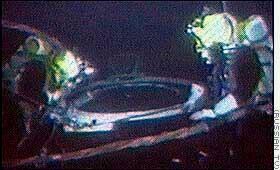Co-editors: Seán Mac Mathúna • John Heathcote
Consulting editor: Themistocles Hoetis
Field Correspondent: Allen Hougland
|
The tragedy aboard the Kursk - best site Navy Spokesman Denies Fresh Kursk Findings Crash of the German Lynx in the Mediterranean and a possible connection to Kursk |
 On Saturday, August 12th 2000, the giant Russian nuclear submarine Kursk - carrying a crew of 118 - sank in the icy waters of the Barents Sea after what Russian officials described as a "catastrophe that developed at lightning speed." More than a week later divers opened the rear hatch of the sub but found no survivors. Our in-depth special examines the submarine, the disaster and the aftermath. The sinking of the submarine the Kursk might not be as straightforward as the collapse of unmaintained Russian hardware, or incompetence. Reports of collision causing sinking of the Kursk are still being issued by defence personnel in Russia. In The Guardian of September 5th 2000 , a report from Moscow quotes a senior Russian officer who claims that the Kursk was sunk in collision with a NATO vessel, probably a British or American spy sub. Repeating claims made by various Russian defence sources soon after the tragedy occured, Colonel General Manilov, deputy Chief of the General Staff said The Kursk probably collided with another submarine whose keel cut open the nose of the (Kursk) submarine and possibly damaged the hull . . . The collision version is also confirmed by the nature of the other damage to the Kursk - the damage to the tower and the fact that its railings were removed. The General continued by telling journalists that Russian rescue vessels had located debris nearby which resembled: ". . . the railings of a conning tower similar to those fitted on American and British submarines." The Russians had not been able to raise this object yet, but were guarding it with battleships. Their suspicions that foreign vessels may have been involved was heightened by the discovery of what appeared to be an underwater hillock, or raised area 500 metres from their sunken submarine, which subsequently disappeared. Although NATO sources have been quick to deny any collision between the Kursk and one of their vessels, they admitted to having two spy submarines in the Barents Sea at the time watching the manouveres of the Russian Fleet. Although officially declining to name either, the name of one of the submarines was leaked in Washington. According to Veniks Aviation Page: Further discussion of the accident among Russian submarine experts in private and on the pages of the Russian press, comes to a following conclusion: "Kursk" was deliberately rammed either by a large foreign submarine or by an unmanned submarine-torpedo (a project being developed by the U.S. for the past 15 years.) The Russians later claimed that the other - unnamed - submarine was the USS Toledo, now docked in Faslane nuclear base, Scotland. Article reprinted from the Russian GazetaOn Monday General Manilov told a press conference that the latest findings at the scene of the sunken Kursk submarine serve as further proof that the most likely cause of the accident, which caused the K-141 class nuclear submarine to sink, was a collision with a large submersed object weighing about 8-9 tonnes. Manilov reiterated the commission's assumption that the object was most likely a foreign submarine. |
|
|
|